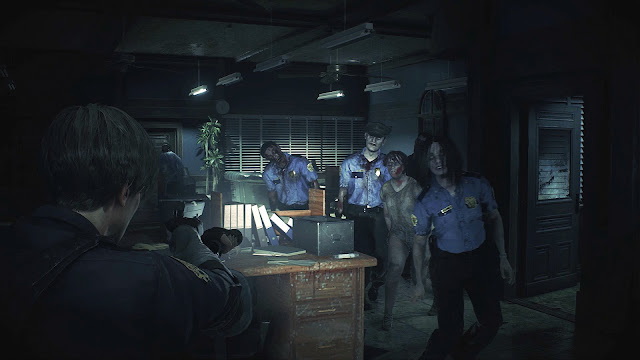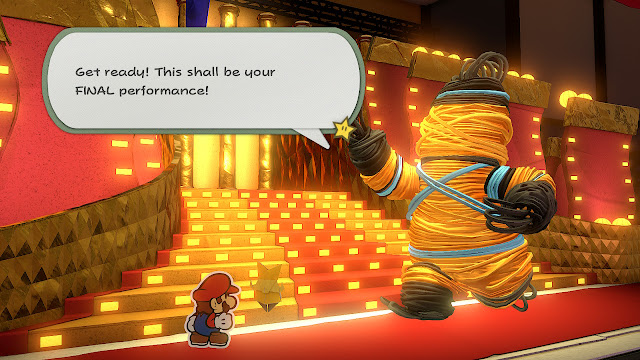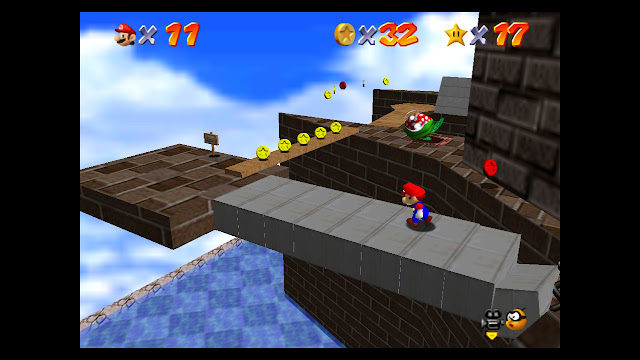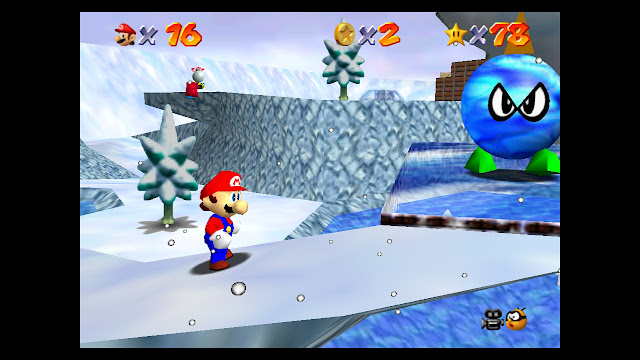We move from a game that was scary and good to games in a collection that are scary good with Super Mario 3D All-Stars. Not only is the collection reviewed, but I also briefly talk about my experiences with each game that is a part of the collection as well. Here is the hefty SPC review of Super Mario 3D All-Stars.
Jump Up, Superstars.
Mario is synonymous with video games. Heck, he IS Mr. Video Game, as far as the industry is concerned. Hence, that is why it's a little disappointing that Nintendo hasn't provided a package worthy of his name. While the three 3D Mario games in the Super Mario 3D All-Stars collection are without question iconic and excellent games all to themselves--and the retouched remasters seen here are executed well enough--it's a shame that so little effort has been placed into this collection, a celebration of Mario's 35th anniversary.
Still, Super Mario 3D All-Stars does feature three iconic and historic games, and I happily played through all of them to completion. It only makes sense to go through each one-by-one before ultimately reviewing the entire collection as a whole. For starters, let's go back in time to 1996.
~Super Mario 64~
We begin with the 3D Mario that started it at all and created a revolution in gaming. There's no question that in 1996 Super Mario 64 delivered and dominated imaginations and inspired countless of developers and designers for decades--and still does. The Nintendo 64 controller was custom built specifically for the game, so using a different controller in either the Switch Joy-Cons or the Pro Controller makes for an understandably different experience.
If one were to judge Super Mario 64 on historic value alone, it would be one of the greatest games of all time, up there with The Legend of Zelda: Ocarina of Time and Super Mario World. But, as a game in 2020--and on the Nintendo Switch--it's one not without its own problems.
For one, Mario doesn't quite turn on a dime like he does in future Mario outings. He makes wide turns, which makes trying to change directions on narrow or small platforms an absolute nightmare. This is particularly true in courses with huge falls or worse yet, courses with bottomless pits. You can find yourself turning Mario off of a platform and to his doom quite easily.
Further, the camera, though a pioneer at the time of release, is obviously quite antiquated in 2020. It's prone to getting caught on geometry, moving on its own mid-jump or mid-run by Mario, and absolutely hates working well when in indoor areas. It results in multiple occurrences where you're actively fighting the camera, among all of the other enemies like Goombas and Piranha Plants that Mario already has to deal with.
That said, while the negatives do make Super Mario 64 a less enjoyable experience, and a quite challenging game--and sometimes for all the wrong reasons--the game still holds up remarkably well. It's a cinch to see why many designers and developers took and still take lessons from the design philosophy of Super Mario 64.

Super Mario 64 sees Mario arriving to Princess Peach Toadstool's castle after receiving an invitation. Prepared for celebration, Mario leaps out of the opening pipe to a hauntingly quiet outside courtyard with nary a welcome in sight. This opening courtyard serves as a nice playground for players to get accustomed to some of the tricks in Mario's wide repertoire of moves. Signposts along the hilly, tree-covered courtyard reveal all manners of moves and how to perform them. Upon arriving at the moat near the castle's entrance, Mario meets Lakitu, who the designers cleverly assign a cameraman role to, contextualizing things brilliantly. Plus, it also assigns some blame when those unwanted and distractingly bad camera angles rear their ugly head in.
Upon entering the castle, Bowser's voice bellows and taunts Mario, revealing that he has trapped the castle's denizens including Princess Peach within the walls and paintings inside. It's up to Mario to enter into each world within the walls and paintings to collect enough Power Stars to open up new sections of the castle, battle Bowser, and save the day once more.
The 15 worlds of Super Mario 64 feature an abundance of locales and themes to them, all open and expansive, bringing forth the sandbox-style of 3D Mario and 3D platformers in general that continues to this day, specifically with the latest in the series, Super Mario Odyssey. The worlds take place in all sorts of settings, such as a mountain and surrounding valley dominated by Bob-Ombs and their king, an underwater world home to secret caverns and a sunken pirate ship, and even a rainbow ride in the sky, complete with death-defying jumps that Mario must make to survive.

Each world possesses six base Power Stars to collect, and many of these can be nabbed out of sequence. For instance, it's entirely possible to acquire the Power Star for breaking the Chain Chomp free in Bob-Omb's Battlefield when it's actually the sixth star on the mission list, even when you're doing the first mission of the world, which is to run up the mountain and face King Bob-Omb for his Power Star. The opening mission list doesn't just list what Power Star you should go after: the name of each Power Star mission is also a clue as to how to get it. For example, Hazy Maze Cave's "A-maze-ing Emergency Exit" hints at which section in the expansive, labyrinthine world you can find the Star, notably the hazy cave itself. Though, sometimes specific Power Star clues offer little guidance, such as Whomp's Fortress' "Break Away the Wall", which obviously hints to break a wall, but it doesn't say how to do so, or even which wall to specifically smash through to get your prize.

Alongside the 15 themed worlds, there are myriad hidden Power Stars within the castle to find. Some are in special levels of their own, such as three levels that unlock unique cap power-ups for Mario to utilize. These are the Wing Cap, Metal Cap, and Vanish Cap, all giving Mario special, temporary abilities like the power of flight, the power of invincibility, and the power of invisibility. However, I must add that the Wing Cap is especially unwieldy to control on the Switch, as any modicum of movement can result in Mario moving out of control.
Super Mario 64 sees a fantastic visual improvement in this collection. While the game does not stretch to full screen, instead leaving black bars to the sides, the game does reportedly upscale to 720p. This is a huge boost compared to the original game. Super Mario 64 has never officially looked better than it does now, with its crisp, colorful, and clean graphics.
Obviously dated by virtue of being a nearly 25-year-old game, Super Mario 64 still manages to impress with its marvelously designed worlds, creative missions and objectives, overall solid platforming and tools provided to Mario to do said platforming, and clever secrets. The game's camera makes for a bothersome time occasionally, particularly in later levels, but overall, Super Mario 64 stands the test of time.
[SPC Says: A-]
~Super Mario Sunshine~
We move from one of Mario's most loved and revolutionary outings to one of Mario's most muddied and maligned outings. Super Mario Sunshine might have needed more time outside to get a serviceable tan (my way of trying to be clever and say the game needed more time in the oven, development-wise), but there's no denying on my end that the game is charming and features one of Mario's most sophisticated and enjoyable move sets in his history.
That notion has to do with FLUDD, the water nozzle accessory that Mario gets equipped with in order to clean up Isle Delfino after being wrongfully accused and charged of defacing the island with graffiti. Not quite the vacation that Mario was expecting, that's for sure. That said, what is Mario's punishment is the player's joy with cleaning up Isle Delfino and navigating its wide open spaces being an absolute pleasure to do... on most occasions.

FLUDD isn't just used to spray enemies, graffiti, and goop away. (Though this is performed with the R and ZR buttons respectively for a weak spray and a stronger spray in the Switch version of Sunshine, as opposed to the GameCube version's pressure-sensitive spraying with one shoulder button.) Mario can use FLUDD in conjunction with and to complement his platforming, using it to hover and reach higher places, even skipping sections of levels. This makes it so there's a high level of freedom in how players take on and approach the various missions and episodes within the game's seven main worlds.

Unlike Super Mario 64, episodes to earn Shine Sprites in Super Mario Sunshine must be played in order, as episodes essentially change the scenarios and levels themselves up considerably from episode to episode. Also unlike Super Mario 64, where you could collect any Power Stars to reach the requisite amount needed to beat the game, in Super Mario Sunshine you have to at least complete the first seven episodes of each world to reach the final area of the game. This makes for a much more difficult experience and one that's a bit more linear structure-wise.
Some of the mandatory episodes and missions that Mario faces aren't exactly the easiest to overcome, either. For instance, rolling watermelons in Gelato Beach up a narrow pier or entering the deadly and dangerous underside of Pianta Village still haunt my dreams. However, for every overly difficult (and usually for the wrong reason) episode in Super Mario Sunshine, there's multiple that offer a great deal of fun. Many of these are episodes dubbed "secrets" where Mario enters a bonus stage where the true culprit of Isle Delfino's graffiti takes FLUDD from him, forcing Mario to engage in a platforming level by his own skills with no safety net in FLUDD to use.

Super Mario Sunshine does have a sharp decline in worlds compared to Super Mario 64, and while there are but seven worlds to explore in the game, each possesses eight episodes to play through, each earning Mario a Shine Sprite for completing them--the Power Star equivalent in Sunshine. Still, even with eight episodes or missions to complete for each world, that still leaves dozens of the 120 Shine Sprites left unaccounted for.
Some Shine Sprites are earned in each world from collecting 100 coins, a much more challenging proposition than in Super Mario 64, as some episodes don't even feature enough coins at all to reach 100 for the Shine Sprite, making for a frustrating and time-consuming fool's errand. But, by far the most troublesome aspect of going for 120 Shine Sprites is that of Blue Coins. There are 30 in each main world. Many of these only appear in specific episodes, and there is no way to track which are in which. The only thing the game does track is how many overall you've collected in a world. Additionally, several Blue Coins are in such ridiculously obtuse locations that it makes trying to track them all down without the assistance of a guide rather foolhardy and frustrating to do.

Super Mario Sunshine suffered from an initial shortened/rushed development cycle. It certainly shows. Some levels such as the Pachinko board, that darned lily pad ride over a poison river, and that Chuckster bonus stage are but some of the poorly designed, poorly executed sections in the game. Thankfully, most of these are optional unless you wish to collect all 120 Shine Sprites. Couple these problematic sections with several bugs and glitches that are uncharacteristic of the Mario series, and a sometimes poor camera, and you have a Mario game that can greatly annoy.
Yet, even with all of these issues, I still found myself adoring the game. Isle Delfino, more than any other 3D Mario location, feels like a living, breathing place. It's charming, it's enjoyable to run, jump, and play through, and its sense of place--particularly being able to stand in Ricco Harbor and see Pinna Park and Gelato Beach in the far distance as if you were in an interconnected place--is phenomenal. The hub world, Delfino Plaza, also remains one of my favorites to explore and run around in. The overall tropical setting of Super Mario Sunshine is so warm, so welcoming, even if the game itself can often frustrate. All in all, Super Mario Sunshine does have many problems, but somehow I was still able to find a lot of fun within the sun-drenched shores of Isle Delfino.
[SPC Says: B+]
~Super Mario Galaxy~
Going in to Super Mario 3D All-Stars, I knew which game of the three I considered my favorite. It was this one: Super Mario Galaxy. Now, after playing through all three games with 100% completion achieved, I am pleased to stand by that opinion. However, that's not to say that Super Mario Galaxy completely sticks its landing, at least in this collection.
Super Mario Galaxy sees Mario enter into an adventure in outer space to take on Bowser, who has sealed himself, Princess Peach, and her castle into the center of the universe. With the help of Rosalina, her Luma helpers, her Comet Observatory, and the Power Stars, Mario aims to dig deeper into the universe, ultimately to reach Bowser, save Peach, and stop whatever plan the King of the Koopas is brewing this time around.

Right away, when you start playing Super Mario Galaxy, you'll see that this isn't your traditional 3D Mario. You're not running in typical Mario environments, but instead completely fantastical ones on multiple axes. You're running around myriad individual planets, both big and small, with their own gravities, and instead of the sandbox worlds of Super Mario 64 and Sunshine, Super Mario Galaxy employs more linear levels. It's more akin to Super Mario Bros. where you go from the start of the level to the goal, rather than being dropped into an open world playground where the world is your oyster to explore. Though, that isn't to say there isn't some of the latter in Galaxy, such as in the Honeyhive Galaxy, for instance.

Super Mario Galaxy is a masterclass of level design. The amazing abundance of amount of creativity in ideas and concepts presented is truly outstanding. This is the type of game that even more than a decade later, the ideas on display still astound me, and I pretty much kept a goofy smile of wonder and happiness on my face the entire time through. The more streamlined approach in level design brings with it a more finely tuned experience, and one that I think works remarkably well. Whether it's hitching a ride on a dandelion puff through Gusty Garden Galaxy as the incredible orchestral soundtrack backs the action or exploring the hot and cold expanses of Freezeflame Galaxy, there wasn't any time I wasn't having fun with Super Mario Galaxy.

One of my biggest concerns with this particular 3D entry coming in to the Super Mario 3D All-Stars collection was how the motion control segments would work. This concern wasn't totally well-founded, but there are some drawbacks. First, onto the good: in order to perform Mario's signature spin move in Super Mario Galaxy, you just need to hit the Y button as opposed to shaking the controller. The spin move is used as not only a means to gain height and control over Mario mid-air, but also allows the player to more easily attack foes without the need for the same level in precision as jumping on them would require.

When it comes to the actual segments that require motion controls, however, these are contextual in the very sense of the word. For things that utilized the Wii Remote's pointer functionality like collecting Star Bits, interacting with Pull Stars, and pushing Mario in a bubble, these things work well enough--though it was quite normal to have to hit the R button to reset the cursor to its default position, as the game and controller would routinely lose its tracking. But when it concerns more complicated sections like manta ray surfing or marble rolling, these sections definitely irritated. In handheld mode, however, all of the motion control isn't welcomed at all. That's because you're expected to touch the screen to perform all pointer-related actions, which isn't practical when you're often having to move Mario at the same time, and somehow moving the entire Switch in your hands to control a manta ray or marble just doesn't feel that natural... Call me crazy, though.

Still, Super Mario Galaxy mostly remained a pleasure to play from beginning to end. The occasional frustrating bout with the motion control segments did displease me at times, but the overall experience was a net positive. From the stunningly updated and enhanced graphics that make the game look better than ever before, to the stellar soundtrack and smartly crafted levels, Super Mario Galaxy oozes with charm, overflows with quality, and just makes for one of my favorite Mario games ever made.
[SPC Says: A]
~The Collection~
Bare-bones is what I would call this collection at best. When we're so used to seeing collections of old titles, such as Sega Genesis Classics or even collections from individual series like this year's Mega Man Zero / ZX Collection with their bonus content, border customizations, and in Genesis's case, a rewind feature, it makes the total package of Super Mario 3D All-Stars sting.
But, perhaps instead of complaining about what's not in this collection, let's go over what IS in this collection. Starting up the game, you get greeted by quick intro, followed by the splash screen. You then receive the main menu, which has three games on individual pages that you cycle through the D-Pad or analog stick. Each decidedly classy page features the game name, release date, and short description on the left side, and a video showcase on the right side.
You can also opt to listen to each game's full soundtrack, even turning off the Nintendo Switch's screen in the process to save battery life while you do so. Though, while it's nice to have all three soundtracks available in the game to listen to on one's Switch, it'd be better to have the soundtracks available in places that aren't as stuck in the past as Nintendo apparently is, such as iTunes or Spotify, for instance.
The most egregious part of Super Mario 3D All-Stars isn't the bare-bones presentation, but the complete lack of control options. As an example, Super Mario Sunshine might be borderline unplayable for some players because there is no way to invert the aiming controls of FLUDD. It's Nintendo's way or the highway, and Nintendo apparently knows better than you do on how you prefer to play their games.
All of this notwithstanding, it says a lot about how excellent the games included in this otherwise ho-hum package are in that I still recommend Super Mario 3D All-Stars. The games are just as good as, or in some cases, better than they've always been. The lack of Super Mario Galaxy 2 is certainly a bummer and very much missed, but ultimately, Super Mario 3D All-Stars' trio of games is some of the best games in this industry. That alone puts it as an easy recommendation for me, not because of Nintendo's decidedly lazy approach to packaging these games--but despite it.
[SPC Says: A-]




































